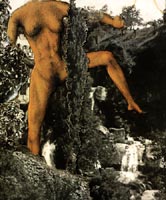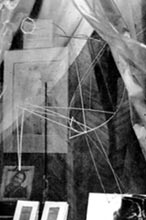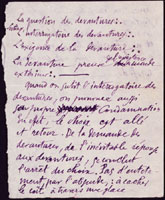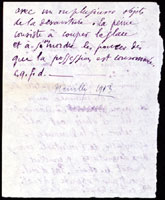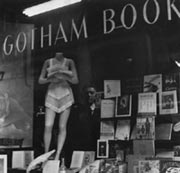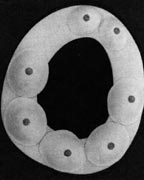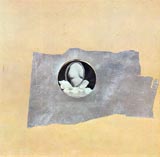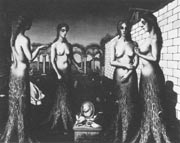by Thomas Girst
|
|||||||||||||||||||||||||||||||
|
Maria Martins
We already know Maria Martins purchased Magritte's Le Modèle Rouge on Duchamp's advice. Their love affair has been well-documented elsewhere (30) . Duchamp would make sure that important works would end up in her collection, just like his Coffee Mill of 1911 (Fig.39), whose importance for his oeuvre he often praised in interviews once it was hers. Breton, of course, knew Maria Martins as well (31) and so did Enrico Donati (32) . Before Marcel Duchamp married Teeny in 1954, it was Maria Martins who was the Bride, enfin arrivée – she had finally arrived (33) , married to another man.
It is time now to devote our full attention to the wire sculpture below the "paper fall," below the "Bride's veil." In her letter to her husband, Isabelle Waldberg claimed it was hers and it closely resembles her "constructions" of the time. Yet, as she herself wrote, "Marcel naturally did everything." Only two years before the first known sketches (Fig.40) (34) of the female Figure for Given and at a time when Duchamp was already involved with Maria Martins, Waldberg's skeletal wire sculpture bears a close resemblance to the strangely distorted body of Given: the head and one arm hidden, the other outstretched, legs spread far apart, one straight and the other sharply bent at the knee, the triangle of genitalia exposed (35) :
For Duchamp's initial introduction of Given in 1945, there could not have been a better setting than a shop window, a work secretly linking Maria Martins to Marcel Duchamp, inextricably bringing the two together in this primal hint at Given's appearance, a work that would occupy Marcel Duchamp during the next twenty years until shortly before his death. In a note written in 1913 and published in A l'Infinif, his White Box of 1967, appearing a year after Given's completion, Duchamp had unmistakably alluded to the forbidden erotic sensation of the shop-window, the round trip rendez-vous of onlookers and objects, the orgasm through a sheet of glass, the consummation achieved by breaking it, silhouettes emerging.
The question
of shop windows:.
Notes
34.
This second study
for Given depicts a waterfall running through the legs of headless
female, leading Duchamp scholar Herbert Molderings to the conclude that
Duchamp first perceived of Given's Figure as a pisseuse,
standing upright. To him, therefore, another shop window of 1945 is
of crucial importance: Duchamp's installation for Breton's Arcane
17 at the Gotham Book Mart in April (conversation with the author,
November 24, 2001). Within the window, Duchamp uses a mannequin to whose
bare leg a faucet is attached. In this respect, Duchamp's little-known
wedding gift to Julien and Jean Levy becomes more significant. For
Sitting Only was presented at the wedding on January 20th, 1957,
in Bridgewater, Connecticut. It is a toilet seat to which seven falsies
– nipples painted pink - are affixed, leaving space for the legs of
the "sitter." The falsies, of course, were the same ones used
in collaboration with Enrico Donati for the deluxe edition of Le
Surréalisme en 1947 (for a first reproduction and brief description
of the work, see: Jennifer Gough-Cooper and Jacques Caumont, "Ephemerides,"
n. pag. [20 January 1957]).
35.
In a telephone conversation with Michel Waldberg (see footnote 11),
the son of the artist is convinced that the lost sculpture was one of
his mother's, suggesting that Duchamp might have chosen it because of
the likeness to what he secretly had in mind. The material used in Waldberg's
sculpture cannot be clearly defined, however. Hans Christoph von Tavel's
Isabelle Waldberg: Skulpturen 1943-1980 (Bern: Kunstmuseum Bern,
1981 [exh. cat.]) states that all of her New York "constructions"
were made of bent twigs, with wire "constructions" only appearing
in her oeuvre upon Waldberg's return to Europe in 1946 (p. 10). Both
wire and wood would have suited Duchamp well. Given's torso rests
on tree branches and he often referred to the Bride in his Large Glass
as "arbor type", with its roots in "the skeletal part
of the bride" (see: Michel Sanouillet and Elmer Peterson (eds.),
The Writings of Marcel Duchamp, New York: Da Capo, 1989, pp.
42, 43). Already in 1942, Duchamp had made the small collage In the
Manner of Delvaux, showing a female breast appearing in a mirror.
This image itself was a detail appropriated from Paul Delvaux's painting
Dawn, 1937, in which four women, naked from the waist up, seem
to emerge from solid tree trunks (see Arturo Schwarz, Complete Works,
p. 224). Figs.
39-42,
Footnote 34, 35
|
|||||||||||||||||||||||||||||||

